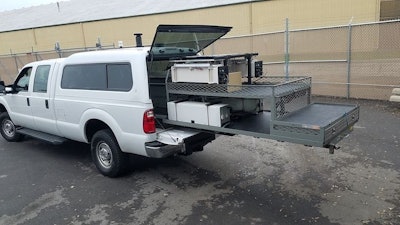 SIGMA+ sensors detecting the entire spectrum of weapons of mass destruction threats slide into the back of a police vehicle with additional space on the racks for regular police cargo. (Photo: DARPA)
SIGMA+ sensors detecting the entire spectrum of weapons of mass destruction threats slide into the back of a police vehicle with additional space on the racks for regular police cargo. (Photo: DARPA)
The Defense Advanced Research Projects Agency (DARPA), in partnership with the Indianapolis Metropolitan Police Department (IMPD), recently concluded a three-month-long pilot study with sensors intended to support early detection and interdictions of weapons of mass destruction (WMD) threats.
The pilot, a part of DARPA’s SIGMA+ program, involved integrating highly sensitive chemical, biological, radiological/nuclear, and explosive (CBRNE) sensors into several IMPD vehicles and gathering real-world environmental background data over a large part of the Indianapolis metropolitan region, building on a smaller event conducted in Indianapolis in August 2020.
“The Indianapolis pilot study and field testing marked the first time we were able to demonstrate the integration of cutting-edge SIGMA+ sensor technology across the entire CBRNE threat space into a law-enforcement (LE) vehicle,” said Mark Wrobel, SIGMA+ program manager in DARPA’s Defense Sciences Office. “The ultimate goal is to outfit a citywide fleet of LE or other public service vehicles to enable a continuously refreshed mobile network that can detect WMD threats with low false-alarm rates across a city or region.”
DARPA also worked with IMPD to understand how SIGMA+ advanced sensor systems could support broader law enforcement mission needs, including holding several workshops with IMPD stakeholders. The workshops addressed current sensor and analytics capabilities and how these capabilities could address mission areas such as detecting narcotics manufacturing.